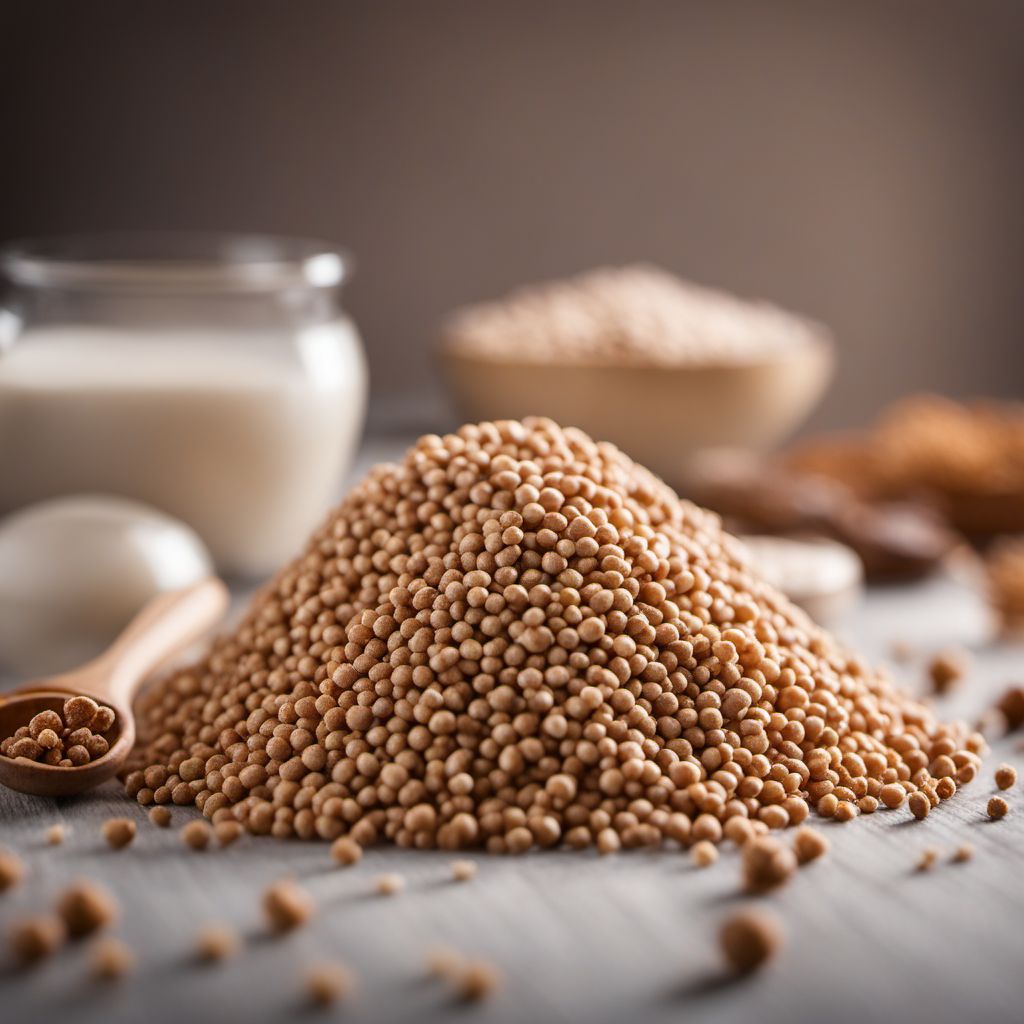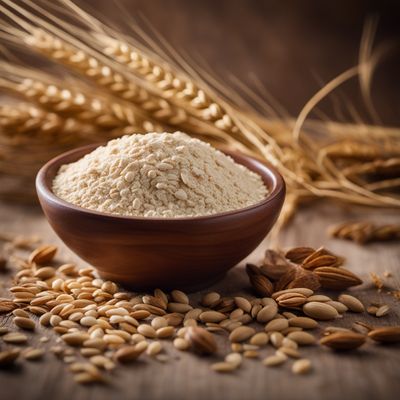
Ingredient
Buckwheat flour
The Nutty Powerhouse: Buckwheat Flour
Buckwheat flour is a gluten-free flour made from ground buckwheat groats. It has a distinctive nutty and earthy flavor that adds depth to recipes. The flour has a light brown color and a slightly coarse texture. It is commonly used in baking, particularly for pancakes, bread, and noodles. Buckwheat flour can also be used as a thickening agent in soups, stews, and sauces.
Origins and history
Buckwheat is believed to have originated in Central Asia and has been cultivated for thousands of years. It is a staple ingredient in many cuisines around the world, including Russian, Japanese, and Eastern European. Buckwheat flour gained popularity as a gluten-free alternative to wheat flour, making it suitable for individuals with gluten sensitivities or celiac disease. It is rich in nutrients and offers numerous health benefits.
Nutritional information
Buckwheat flour is a good source of fiber, protein, and essential minerals such as magnesium and manganese. It is also rich in antioxidants and has been associated with various health benefits, including improved heart health and blood sugar control. Additionally, buckwheat flour is naturally gluten-free, making it a suitable option for individuals with gluten sensitivities or celiac disease.
Allergens
Buckwheat flour is naturally gluten-free, but cross-contamination may occur during processing. It is important to choose certified gluten-free buckwheat flour if you have gluten sensitivities or celiac disease. Additionally, some individuals may have allergies to buckwheat, although it is relatively rare.
How to select
When selecting buckwheat flour, look for brands that are labeled as gluten-free and made from 100% buckwheat. Check the expiration date to ensure freshness. Store buckwheat flour in an airtight container in a cool, dry place to maintain its quality and prevent moisture absorption.
Storage recommendations
Buckwheat flour should be stored in a cool, dry place away from direct sunlight. It can be stored in an airtight container or resealable bag for up to a year. To extend its shelf life, you can also store buckwheat flour in the refrigerator or freezer.
How to produce
Buckwheat can be grown in home gardens or containers, making it accessible for amateur gardeners. It thrives in well-drained soil and requires minimal maintenance. The plant produces small, pyramid-shaped seeds that can be harvested and ground into flour. Growing buckwheat at home allows you to have a fresh supply of buckwheat flour for your culinary creations.
Preparation tips
Buckwheat flour can be used as a substitute for wheat flour in various recipes. It is commonly used in gluten-free baking, such as pancakes, muffins, and cookies. Buckwheat flour can also be used to make noodles, crepes, and bread. Its nutty flavor pairs well with both sweet and savory dishes. When using buckwheat flour in recipes, it is advisable to combine it with other gluten-free flours or starches to achieve the desired texture and structure.
Culinary uses
Buckwheat flour is commonly used in Eastern European cuisine, particularly in dishes such as blinis, kasha, and soba noodles. It is also a key ingredient in Japanese cuisine, where it is used to make soba noodles and various traditional sweets. Buckwheat flour can be found in gluten-free and health food stores, as well as some mainstream supermarkets.
Availability
Russia, Japan, Eastern Europe
More ingredients from this category » Browse all

Rye flour
Hearty Grain

Barley flour
The Nutritional Powerhouse: Barley Flour

Wheat flour
The Versatile Grain: Exploring the Wonders of Wheat Flour

Amaranth flour
The Ancient Grain Flour with a Nutty Twist

Oat flour
The Wholesome Power of Oat Flour

Cereal and cereal-like flours not separately listed
The Flour Power: Unleashing the Versatility of Cereal and Cereal-Like Flours

Millet flour
The Ancient Grain: Millet Flour

Sorghum flour
Sorghum Flour: A Nutritious and Gluten-Free Alternative

Spelt flour
The Ancient Grain of Spelt

Rice flour
The Versatile Grain Powder

Maize, milled
Golden Grain: Unleashing the Power of Milled Maize

Flour mix (like wheat/rye/barley/oats and other)
Versatile Blend for Every Recipe
Recipes using Buckwheat flour » Browse all

Galette-saucisse with Caramelized Onions and Dijon Mustard
Savory French Galette-saucisse: A Delightful Twist on a Classic Street Food

Mylene's Delightful Crêpes
French Elegance: Heavenly Crêpes with a Delicate Twist

Slovenian Buckwheat Spoonbread
Hearty Buckwheat Delight: Slovenian Spoonbread

Sobagaki with Kinako Sauce
Deliciously Nutty Sobagaki: A Traditional Japanese Delight

Crispy Cheese Fritters with a Twist
Savory Cheese Delights: A Modern Twist on Italian Sciatt

Smoked Salmon Blinis with Dill Cream Cheese
Savory Delights: Smoked Salmon Blinis with Creamy Dill Cheese

Creamy Polenta Taragna with Mushroom Ragout
Savory Delight: Creamy Polenta Taragna with Earthy Mushroom Ragout

Greek-American Vínarterta
Layers of Greek-American Delight: A Modern Twist on Vínarterta

Franconian Goshiki-ito
Savory Franconian Delight: Goshiki-ito with a German Twist

Savory Buckwheat Rolls with Filling
Hearty Slovenian Buckwheat Rolls: A Taste of Tradition

Schwarzplententorte with a Twist
Austrian Delight: A Modern Twist on Schwarzplententorte

Homemade Soba Noodles with Sesame Sauce
Savory Delights: Handmade Soba Noodles with Irresistible Sesame Sauce